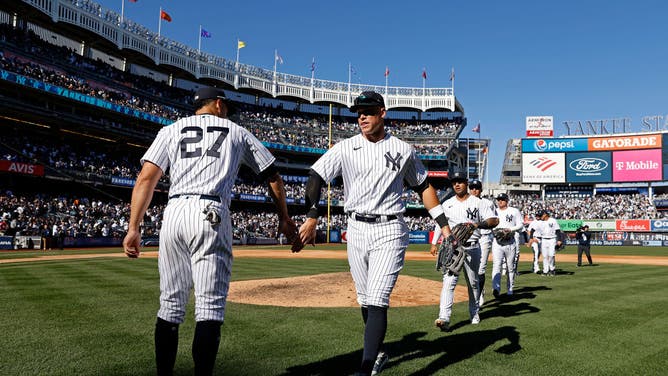MLB Now Gives Us Bat Speed Data, But Does It Matter?
Swing bat fast, hit ball far. Sounds about right, doesn't it?
Not necessarily.
Major League Baseball now provides data on the bat speed of individual players on its Baseball Savant page. And there's a wealth of new information available to fans, teams and analysts that could provide clues as to what type of swing and speed of swing generates better quality contact.
Thanks to the new leaderboard, we can see that the list of fastest average swings shows some clear patterns.
- Giancarlo Stanton
- Oneil Cruz
- Kyle Schwarber
- Matt Chapman
- Ronald Acuna Jr.
- Christopher Morel
- Jo Adell
- Aaron Judge
- Julio Rodriguez
- Juan Soto
- Yordan Alvarez
- Willson Contreras
- Mike Trout
- Jorge Soler
- Vladimir Guerrero Jr.
Stanton has, by far, the highest average bat speed at 80.6 mph. Guerrero is at 75.6, with Cruz at 77.9. There's a bigger gap from the second place Cruz to first place Stanton than there is from Cruz to 15th place Guerrero.
Unsurprisingly, other physically large, strong hitters like Aaron Judge, Jorge Soler and Kyle Schwarber are on the list too. There's plenty of elite talent on the list; Ronald Acuna, Julio Rodriguez, Mike Trout and Soto are elite players. Gunnar Henderson and Shohei Ohtani ranked 17th and 18th as well.
But what does it all mean, and what other factors are important to examine?

NEW YORK, NY - APRIL 2: Aaron Judge #99 high fives Giancarlo Stanton #27 of the New York Yankees after defeating the San Francisco Giants at Yankee Stadium on April 2, 2023 in New York, New York. (Photo by New York Yankees/Getty Images)
Swing Speed Matters, But It's Not The Only Factor
Along with bat speed data, MLB now also tracks swing length. Meaning, how far the bat travels from the start of the swing to the impact point.
Stanton has the fastest swing, but it's also one of the longest among the top players at 8.4 feet. You'd expect that a fast, long swing would generate a ton of power when connecting on the sweet spot, but it'd also be high variance, leading to more swings and misses. Sure enough, Stanton has frequently struggled with strikeouts, with a career 28.4% K rate.
While the league leaders in swinging strike percentage are often in the low single digits, 3-4%, Stanton swings and misses roughly 15% of the time. He hits the ball harder than almost anyone, with a max exit velocity over 122 mph, but the high variance swing leads to more strikeouts and whiffs. Makes sense.
Meanwhile, fast swinging players with shorter swings like Juan Soto, Mike Trout, Yordan Alvarez and Ronald Acuna Jr. are essentially the best hitters in baseball. Shohei Ohtani, despite swinging with extreme force, also has just a 7.5 foot long swing length, compared to Stanton's 8.4. Javier Baez has an 8.7 foot swing length, meaning that despite a fast swing speed, he's still prone to swinging and missing.
Thankfully, MLB has also created a stat called "Blasts," effectively a "valuable and rare kind of swing, taking only the most valuable combinations of hard swings and contact efficiency." Meaning, how often do players get off what we could describe as their "A" swing with elite contact quality that maximizes the speed they generate.
Juan Soto ranks second, Ohtani third, William Contreras first, and Aaron Judge eighth. A lot of good hitters are able to maximize their swings on a higher percentage of pitches. One other interesting measurement is "fast swing rate," meaning how often players swing their hardest.
Stanton, unsurprisingly, ranks first there too. A staggering 98% of the time, he swings over 75mph. The next highest is Cruz at 74.9%. Max effort, all the time, also leads to variance and likely, more injury. Don't tell Brian Cashman.
READ: Yankees GM Brian Cashman Doubts Giancarlo Stanton Can Stay Healthy For A Full Year
So overall, what does this data tell us?
At this point, nothing has been too surprising; much of the data lines up with the eye test. But what it might tell us over time is how to tell when players age and if players are able to adjust their approach in different counts and situations. Some of that data is already available, but as say, Stanton or Ohtani get into their late 30's, will they be able to maintain that elite bat speed? And if not, how much does it affect their results?
It's a fascinating world of analysis that may help teams better evaluate the effects of injury or the aging curve. And maybe even how to mitigate some of it by shortening bat paths or trying to teach players to focus more on certain types of swings.